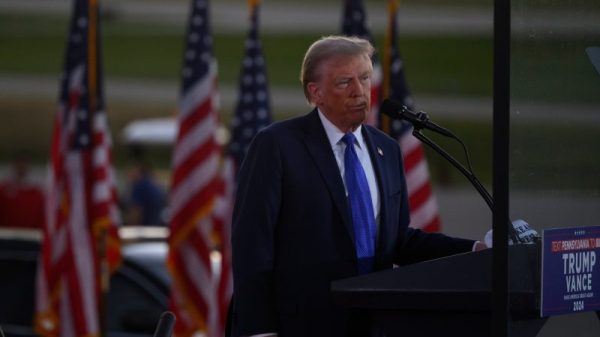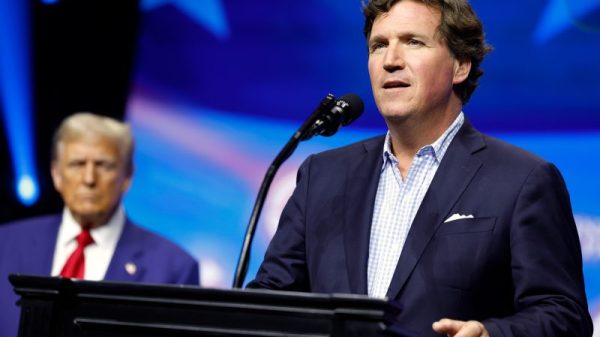A lot has changed in the presidential race over the last three weeks, according to The Washington Post’s polling average.
Since President Joe Biden exited the presidential race on July 21 and passed the baton to Kamala Harris, his vice president, the race has effectively reversed itself. It is no exaggeration to state that Harris would be the favorite to win the White House, according to our polling model, if the presidential contest were held today.
Relative to the day that Biden dropped out, Harris has gained two percentage points nationally and, as of Sunday, leads in our national polling average. In swing states, she has gained an average of 2.1 points since June 21 and leads in 2 of 7 of them.
Harris has taken the lead in Wisconsin and Pennsylvania, and has substantially closed the gap in Michigan, where Donald Trump now leads with less than one percentage point (if this trend continues, we’d expect our average to show a tie in that state in the coming days).
According to our polling model, Harris still trails Trump in the electoral college tally if the election were held today and every state votes as their polling average currently demonstrates. Nonetheless, she would be the favorite if voters today went to the polls because Harris now has more paths to the presidency than Donald Trump — that is, she is competitive in more states that could add up to 270 votes or an electoral college victory.
Our modeling shows that Harris has two paths to possible success: the Rust Belt states of Michigan, Wisconsin and Pennsylvania and the Sun Belt states of Georgia, Arizona and Nevada (she could win in either region and still claim the White House). Meanwhile, Trump must win both the Rust Belt and Sun Belt to triumph.
It is, of course, important to remember that there are still three months until Election Day and Harris has just recently become the Democratic presidential nominee. Polls are simply a snapshot in time and a lot can change between now and Election Day.
But there’s no question something big happened on July 21.
Before the June 27 debate, the presidential race was pretty easy to describe: Biden was behind, both nationally and in the swing states, but was very slowly clawing his way back into contention. In January of this year, Biden was behind Trump by 1.5 percentage points nationally, according to The Washington Post polling average, which we launched in June but also ran retrospectively. By mid-June, that deficit had shrunk to three-tenths of a percentage point.
What followed the debate were five of the most eventful weeks in recent political history. A catastrophic debate performance, an attempted assassination of a presidential candidate, a vice-presidential pick, the Republican National Convention and, most critically, Biden dropping out of the presidential election and endorsing Harris.
After the debate, Biden’s standing in the polls deteriorated pretty quickly. According to our polling average, Biden dropped by more than one percentage point nationally in just the week following the debate, erasing the progress he had made since the beginning of the year. But more importantly, Biden was behind in every single swing state.
After the debate, our polling average showed Biden’s position in the Sun Belt states deteriorating to the point that Trump was ahead by five percentage points in states like Georgia, Arizona, Nevada and North Carolina. In Michigan, Biden had slipped behind Trump by more than three percentage points.
But after Harris entered the race in late July, the election was effectively reset. Compared to other polling aggregators and models, The Post’s model took a bit longer to reflect the changes that came with Harris’s candidacy. That’s because we have chosen to use only the highest quality polls for our model, and not many polls that were released in the last few weeks met our standard.
According to our model now, Harris has become the slight favorite. Nonetheless, there are some caveats and cautionary notes — our polling model is only a snapshot in time and also, polls can err as we’ve seen in the last two presidential elections.
On the face of it, Harris’s small lead in the national polls and trends in swing states don’t look like enough for her to be the favorite in the electoral college. According to our model, Trump continues to lead in a majority of the battleground states — and if you count up the electoral votes and award them to the candidates leading in those states, Trump comes in at 283 and Harris at 255. The first to 270 wins.
The reason Harris is now the favorite is because Harris has closed the gap with Trump in Sun Belt states enough to open a second path to the presidency
Because the polls underestimated Trump in the last two presidential elections, we often associate polling errors with a potential upside for Republicans. But it’s important to remember that polling errors can go either way. And a 2012-sized error (not a cycle we usually associate with an error at all) would now be enough to put Harris over the top.
The other, and more crucial, reason that Harris is favored is that her improvement in the polls has opened up a second path on the presidential battlefield and in the electoral college. The polling suggests that, unlike Biden, she is no longer effectively tied to the Rust Belt — Pennsylvania, Michigan and Wisconsin — to hit 270 electoral votes. As of today, Harris is now only a typically sized polling error away from winning key Sun Belt states. Winning all of Arizona, Nevada, North Carolina and Georgia would also be enough to put Harris over the top and she is continuing to improve her position in those states.
Our model shows that for Trump to win the White House, he would need to notch victories in both the Rust Belt and Sun Belt. But crucially for Harris, she would win by taking just one of those two paths.
For now, that is a game changer.





























